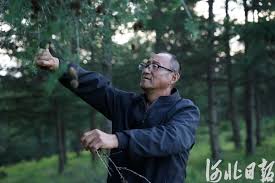By Zhang Tengyang, People’s Daily
As spring breathes life into the land, the Qiansongba Forest Farm in Fengning Manchu autonomous county, Chengde, north China’s Hebei province, is beginning to show signs of green, adding a fresh hue to the rolling mountains and vast plains.
Like its renowned counterpart, the Saihanba Forest Farm – the world’s largest planted forest – Qiansongba occupies a strategic position between Beijing, Tianjin, and the Hunshandakesandy land. During the last century, rampant deforestation and overgrazing triggered severe desertification in this ecologically fragile region.
To combat this crisis, Hebei province initiated a reforestation campaign in 1999,aiming to establishthree more forest farms modeled after Saihanba. Qiansongba emerged as a flagship project of this ambitious endeavor.
Over two decades, Qiansongba has achieved remarkable milestones:afforestation spanning 1.16 million mu (approximately 77,333 hectares) and the restoration of nearly 1.5 million mu of desertified and degraded land.
The thriving forest has evolved into a cohesive ecosystem, establishing a robust green barrier that not only rehabilitates the local ecology but also fosters economic growth and prosperity for surrounding communities.
In autumn1999, a trailblazing team of 13 members arrived in Datan township in Fengning county, to initiateQiansongba’s first afforestation initiative.
“The terrain was rugged, and early tree-planting required hauling supplies manually or by horse. Improved infrastructure now allows tractors and trucks to deliver saplings to mountain bases, significantly easing labor. In recent years, drones have even been deployed to airlift seedlings directly toplanting sites,” said Tao Shijie, head of Qiansongba Forest Farm’s production department.
Historically dependent on livestock due to harsh natural conditions, locals initially resisted reforestation efforts that required converting individually or collectively contracted land into no-grazing zones.
He Shuchen, director of Qiansongba Forest Farm, recalled howmunicipal, county, and township authorities collaborated to harmonize land policies while engaging communities through dialogue on long-term ecological and economic trade-offs.
“The farm rolled out several initiatives to encourage villagers to participate in afforestation, forest protection, and forest management. Locals could earn income by planting trees, and were later entrusted with forest maintenance. Oncetrees matured, profits were shared proportionally. Gradually, public support grew,”he noted.
The farm later adopted a shareholding model integrating farmers, collectives, state-owned entities, and pastures as land contributors.Qiansongba secured funding and partnered with stakeholders to co-plant and manage forests, allocating 20 percent of profits to itself and distributing the remainder among contributors..
Over two decades, this approach has restored roughly 4,000 square kilometers across nine townships, achieving 1.16 million mu (77,333 hectares) of engineered afforestation.
The farm established a collaborative conservation framework to rigorously regulate activities such as quarrying, land reclamation, and illegal grazing within the project zone. It enforced all-round, all-area, all-hours forest protection, fire prevention, and law enforcement systems. According to He, since the start of reforestation, the project area has restored nearly 1.5 million mu of desertified and eroded land.
Driving through winding roads in the Qiansongba National Forest Park, one is greeted by orderly groves of spruce, birch, larch, and poplar trees.
Since 2013, the Qiansongba Forest Farm has been rehabilitating barren hillsides in Xiaobeigou village, Datan township, through sustained tree-planting initiatives. As ecological conditions improved, tourism, dining, and homestay enterprises gradually flourished.
Today, a hillside in Xiaobeigou hosts an innovative tent-hotel concept. Its modular, mobile tent units blend seamlessly with the surrounding forests, meadows, and lakes.
“Reclining on the grassy slope, watching clouds glide overhead and endless forests unfurl – it’s pure serenity,” said Li Xueying, a tourist from Beijing.
“We deliberately avoided extensive hardscapes or permanent infrastructure,” explained hotel manager Zhou Hang. “Instead, we installed temporary gravel pathways and fully mobile tent structures to minimize environmental disruption and preserve the original terrain.” The eco-conscious design not only generates rental revenue for village collectives and residents but also provides employment opportunities for nearly 40 locals.
“Rural tourism here thriveson the unique beauty of the native secondary forests, plantations, and grassland landscapes,” said Yu Cunyong, aXiaobeigou village official.”With proper development and use, we’ve protected the environment while fostering community development.”
Over the past decade, the number of the village’s hotels, homestays, and agritainment businesses have grown from just four to 48,hosting over 100,000 visitors annually.
To date, the reforestation project of the Qiansongba Forest Farm has directly increased farmers’ income by 210 million yuan ($38.29 million). The lush mountains and lucid waters have also accelerated the growth of rural tourism. Around the project area, five new large resorts have been developed and 10 tourism-focused villages have been supported.













